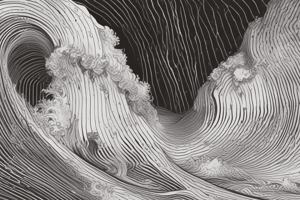Podcast
Questions and Answers
What is the primary effect of a decrease in area on the intensity of an ultrasound pulse?
What is the primary effect of a decrease in area on the intensity of an ultrasound pulse?
- Increases amplitude
- Reduces power
- Increases intensity (correct)
- Decreases frequency
What happens to the amplitude of an ultrasound pulse as it travels through a medium?
What happens to the amplitude of an ultrasound pulse as it travels through a medium?
- It is weakened (correct)
- It remains constant
- It increases
- It is unaffected
What is the 'on' or 'transmit' time during which the ultrasound wave is emitted called?
What is the 'on' or 'transmit' time during which the ultrasound wave is emitted called?
- Pulse duration
- Pulse repetition period
- Dead time
- Cycle (correct)
What is the term for the period during which the transducer awaits the return of the echoes?
What is the term for the period during which the transducer awaits the return of the echoes?
What type of ultrasound is predominantly employed in echocardiography for acquiring Doppler information?
What type of ultrasound is predominantly employed in echocardiography for acquiring Doppler information?
What is the purpose of a pulsed transducer in ultrasound diagnostic imaging?
What is the purpose of a pulsed transducer in ultrasound diagnostic imaging?
What is the frequency bandwidth of a pulsed transducer?
What is the frequency bandwidth of a pulsed transducer?
What is the limitation of continuous wave ultrasound in terms of creating images?
What is the limitation of continuous wave ultrasound in terms of creating images?
What is the reciprocal of Pulse Repetition Frequency (PRF)?
What is the reciprocal of Pulse Repetition Frequency (PRF)?
What is the effect of increasing the number of cycles in a pulse on Pulse Duration?
What is the effect of increasing the number of cycles in a pulse on Pulse Duration?
What is the relationship between Pulse Repetition Frequency (PRF) and imaging depth?
What is the relationship between Pulse Repetition Frequency (PRF) and imaging depth?
What is the unit of measurement for Pulse Duration?
What is the unit of measurement for Pulse Duration?
What is the effect of increasing the Pulse Repetition Frequency (PRF) on Pulse Repetition Period (PRP)?
What is the effect of increasing the Pulse Repetition Frequency (PRF) on Pulse Repetition Period (PRP)?
What is the formula to calculate Pulse Duration (PD)?
What is the formula to calculate Pulse Duration (PD)?
What is the typical range of values for Pulse Repetition Period (PRP) in clinical imaging?
What is the typical range of values for Pulse Repetition Period (PRP) in clinical imaging?
What is the duty factor (DF) in ultrasound?
What is the duty factor (DF) in ultrasound?
What is the primary function of the listening time in a pulsed ultrasound system?
What is the primary function of the listening time in a pulsed ultrasound system?
What is the range of typical duty factors for sonography?
What is the range of typical duty factors for sonography?
How does the pulse duration affect the duty factor in Doppler ultrasound?
How does the pulse duration affect the duty factor in Doppler ultrasound?
What is the formula to calculate the duty factor (DF) in a pulsed ultrasound system?
What is the formula to calculate the duty factor (DF) in a pulsed ultrasound system?
What is the primary difference between continuous wave ultrasound and pulsed wave ultrasound?
What is the primary difference between continuous wave ultrasound and pulsed wave ultrasound?
What is the spatial pulse length (SPL) dependent on?
What is the spatial pulse length (SPL) dependent on?
What is the effect of attenuation on ultrasound waves as they travel through a medium?
What is the effect of attenuation on ultrasound waves as they travel through a medium?
What is the sonographer able to adjust during an ultrasound examination?
What is the sonographer able to adjust during an ultrasound examination?
What is the unit of frequency that is equivalent to 1,000 Hz?
What is the unit of frequency that is equivalent to 1,000 Hz?
What determines the frequency of an ultrasound wave?
What determines the frequency of an ultrasound wave?
What is the product of frequency and period?
What is the product of frequency and period?
What affects the resolution and penetration of sonographic images?
What affects the resolution and penetration of sonographic images?
What is the symbol used to represent the period of an ultrasound wave?
What is the symbol used to represent the period of an ultrasound wave?
What happens to the frequency of an ultrasound wave as the piezoelectric crystals in the transducer get thinner?
What happens to the frequency of an ultrasound wave as the piezoelectric crystals in the transducer get thinner?
What is the frequency of an ultrasound wave if five cycles occur within one millionth of a second?
What is the frequency of an ultrasound wave if five cycles occur within one millionth of a second?
Can the period of an ultrasound wave be altered by the sonographer?
Can the period of an ultrasound wave be altered by the sonographer?
What was the primary driver for the advancement of SONAR technology during World War I?
What was the primary driver for the advancement of SONAR technology during World War I?
Who is credited with creating an early ultrasound device using piezoelectric principles?
Who is credited with creating an early ultrasound device using piezoelectric principles?
In what era did diagnostic uses for ultrasound start to emerge?
In what era did diagnostic uses for ultrasound start to emerge?
What type of ultrasound technology did institutions worldwide develop in the mid-20th century?
What type of ultrasound technology did institutions worldwide develop in the mid-20th century?
What is a characteristic of pulsed ultrasound transducers?
What is a characteristic of pulsed ultrasound transducers?
What is the limitation of continuous wave ultrasound in terms of creating images?
What is the limitation of continuous wave ultrasound in terms of creating images?
What is the term for the period during which the transducer awaits the return of the echoes?
What is the term for the period during which the transducer awaits the return of the echoes?
What is the reciprocal of the pulse repetition period?
What is the reciprocal of the pulse repetition period?
Flashcards are hidden until you start studying
Study Notes
Ultrasound Physics and Instrumentation
- Decrease in area (focusing) increases intensity because power is more concentrated.
- Ultrasound pulse is weakened (reduction of amplitude) as it travels through a medium, known as attenuation.
- Amplitude is the maximum amount of variation that occurs in an acoustic variable (pressure, in this case).
- Intensity is the power in a sound wave divided by the area over which the power is spread (the beam area).
Pulsed Wave Ultrasound
- A pulse must have a distinct beginning and end.
- Pulsed ultrasound comprises two main components: the cycle (the "on" or "transmit" time) and the dead time (the "off" or "receive" time).
- Pulsed transducers are designed to generate multiple, sequential, short pulses, allowing for the simultaneous use of the same crystal or group of crystals for both sound transmission and echo reception.
- Pulsed wave transducers emit ultrasound waves that span a variety of frequencies, referred to as the frequency bandwidth.
- Pulsed wave transducers are responsible for generating all types of ultrasound diagnostic images, including both real-time and static.
Duty Factor (DF)
- Duty factor (DF) is the percentage of time that the ultrasound system transmits sound.
- DF is calculated by dividing the pulse duration by the pulse repetition period.
- Typical DFs for sonography are in the range of 0.1% to 1.0%, and for Doppler ultrasound, 0.5% to 5.0%.
- The sonographer can adjust the DF by changing the imaging depth.
Spatial Pulse Length (SPL)
- SPL is the length of a pulse from front to back.
- SPL is equal to the length of each cycle times the number of cycles in the pulse.
- SPL determines axial resolution.
- SPL decreases with increasing frequency because wavelength decreases with increasing frequency.
Ultrasound Interaction with Tissue
- Attenuation refers to the progressive reduction in amplitude or intensity of ultrasound waves as they travel through a medium.
Pulse Repetition Frequency (PRF)
- PRF refers to the number of sound pulses generated by the transducer per second.
- There is an inverse relationship between imaging depth and PRF, meaning as imaging depth increases, PRF decreases.
- The sonographer can adjust PRF, and the adjustment is particularly relevant to achieve optimal imaging depth.
Pulse Repetition Period (PRP)
- PRP refers to the time from the beginning of one pulse to the beginning of the next one.
- PRP is the reciprocal of PRF, expressed in milliseconds or any unit of time.
- The determination of PRP is influenced by the sound source, and it can be adjusted by the operator.
Pulse Duration (PD)
- PD is the time that it takes for one pulse to occur.
- PD is equal to the period (the time for one cycle) times the number of cycles in the pulse (n) and is expressed in microseconds.
- Sonographic pulses are typically two or three cycles long, and Doppler pulses are typically 5 to 30 cycles long.
- PD decreases if the number of cycles in a pulse is decreased or if the frequency is increased (reducing the period).
Sound Wave Parameters: Frequency
- Frequency is the number of complete variations (cycles) that an acoustic variable (pressure, in this case) goes through in 1 second.
- Units of frequency: Measured in hertz (Hz), kilohertz (kHz), and megahertz (MHz), where one hertz is equivalent to one cycle per second, one kilohertz equals 1,000 Hz, and one megahertz is 1,000,000 Hz.
- Frequency is determined by the sound source.
- Frequency-period relationship: The product of frequency and period equals 1 second.
Resonance Frequency in Ultrasound Transducers
- The resonance frequency of an ultrasound transducer is primarily determined by its piezoelectric crystals.
- Thinner crystals in the transducer vibrate at higher frequencies compared to thicker crystals.
- Frequency plays a crucial role in determining the resolution and penetration of sonographic images.
- Frequency is adjustable based on the transducer and sonographic instrument used.
The Evolution of Ultrasound Technology
- 1794: Spallanzani's exploration led to the discovery of sound beyond the audible spectrum.
- 1880: The Curie brothers, Pierre and Jacques, identified the piezoelectric effect, foundational for later ultrasound technology.
- 1912: Utilizing piezoelectric principles, Langevin created an early ultrasound device.
- 1917: World War I's naval warfare spurred the advancement of SONAR technology.
- 1930s: Diagnostic uses for ultrasound started to emerge, marking a new era in medical imaging.
- 1942: Dussik published the pioneering study on the ultrasound examination of the brain.
- Late 1940s: The medical industry began experimenting with ultrasound for medical purposes.
- Institutions worldwide developed pulsed ultrasound technology, leading to 'B Mode' imaging.
- The real-time B-scan ultrasound was developed and introduced in obstetric imaging.
- Ultrasound technology expanded with the advent of three-dimensional (3D) and four-dimensional (4D) imaging.
Studying That Suits You
Use AI to generate personalized quizzes and flashcards to suit your learning preferences.




